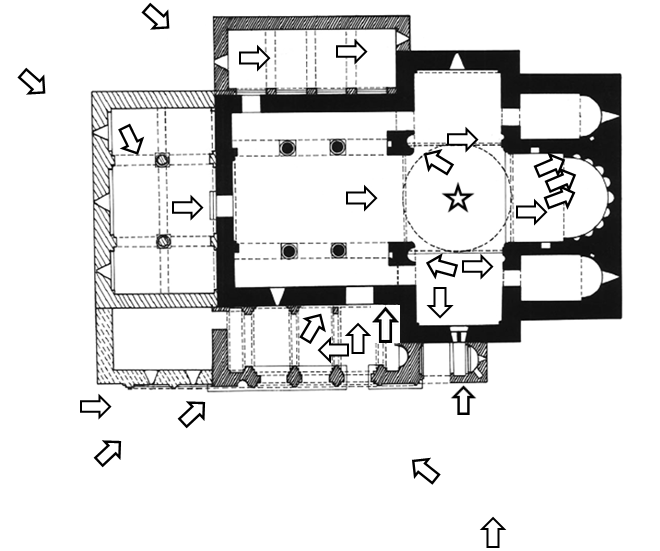Nato Chitizhvili
Khakhuli Monastery is situated in the historic south-western Georgian province of Tao, in present day Bağbaşi village in north-eastern Turkey. The monastery was founded by the representative of the Bagrationi royal family, David Kuropalates, in the 960-970s.
The monastery is surrounded by a stone wall of irregular shape with a gate to the south. The central part of the enclosure is occupied by the main church dedicated to the Virgin Mary. There are also four single-nave churches and chapels in the precinct.
The main church is cruciform in plan, with porches and galleries attached to the west arm from all three sides, which were added in the 11th and 14th centuries. Only the façade of the south gallery is articulated with arcades. The dome of the main church rests on the outer corners of the sanctuary and two massive piers. The western arm is divided into a central nave and two aisles by means of two pairs of piers. The sanctuary is flanked by pastophoria. The apse has eight high semicircular niches arranged symmetrically on both sides of a central window. Below the window, there is a wider and lower niche that served as an archbishop’s throne during the Divine Liturgy. The conch of this niche is filled by the relief of a dove with a halo, symbolizing the Holy Spirit.
Niches of semicircular plan are cut into the eastern sides of the piers supporting the dome. Apparently, these niches served as the place where the highest ranking secular and religious persons attending the liturgy stood and listened. The niche cut in the north-western pier was painted. In front of these niches, at the corners of the sanctuary, there are recesses in the walls for holding icons.
The walls of the church are faced with smoothly finished blocks, both inside and outside, which suggests that originally the interior of the church was not meant for wall painting. However, in the early 11th century it was painted. The murals are well-preserved in the dome where the Apparition of the Cross is represented. The Ascent of Elijah into Heaven is depicted in the drum. In the apse, there are the images of Christ in Majesty, the Virgin Orant flanked by two angels, apostles, and prophets. In the crossarms, the majority of the murals are lost. Only fragments of the Presentation of Christ at the Temple and Entry of Christ into Jerusalem can be seen on the south wall.
Exterior adornment of the church is concentrated around window and door openings. The exterior of the dome is decorated with blind arches resting on twin engaged columns. In comparison with the relatively modest east, west, and north façades, the south façade is particularly rich in decoration. Its twin windows have lavishly adorned frames surmounted by the image of a powerful eagle with half-open wings holding a deer in its claws. The south entrance of the church has an unusually large number of relief sculptures, which frame it on all three sides. In the tympanum, there is the representation of the Exaltation of the Cross by angels; on the left side of the doorway, one can see the depictions of Alexander the Great’s celestial journey, a gryphon, and a lion attacking a bull; on the right side – St Peter holding a key, Jonah and the Whale, a cock, and a lion.
A peculiar feature of the façade decoration of the Khakhuli church is the polychromy created by the application of purple insertions into the yellowish facing. They can be seen above the windows of the drum. Above the eastern, southern, and western windows there are large radiating strips composed of alternating purple and yellowish stones, crowned by Ω-shape ornated brows.
The dome of the church is covered with purple, yellow and green glazed tiles. Images of crosses and birds are presented on the antefixes.
The architecture and decoration of Khakhuli church, as well as its mural painting, demonstrate the highest level of art and architecture in the 10th and 11th centuries in Georgia.
Interactive Plan

Images
Bibliography
- Beridze, V. Architecture de Tao-Klarjetie (Tbilisi, 1981), 292, pls. 59-61, 118.
- Djobadze, W. ‘Observations on the Architectural Sculpture of Tao-Klarjet’i Churches around One Thousand A. D.’, Studien zur spätantiken und byzantischen Kunst, Friedrich Wilhelm Deichmann Gewidmet, Teil II (Bonn, 1986), 81-100.
- Djobadze, W. Early Medieval Georgian Monasteries in Historic Tao, Klardjeti and Šavšeti (Stuttgart, 1992), 142-157, pls. 190-215.
- Scarcia, G. ‘Su un rilievo di Xaxuli con l’“ascensione di Alessandro e su qualche problema connesso’, Georgica, II, Materiali sulla Georgia Occidentale (Bologna, 1988), 97-101.
- Takaishvili, E. Arkheologicheskaya ekspeditsia 1917-go goda d yujhnie provintsii Gruzii (Tbilisi, 1952), 68-75, pls. 84-108.
- Thierry, N. ‘La peinture medieval géorgienne’, Corsi di cultura sull’arte ravennata e byzantine 20 (1973), 411-412.
- Thierry, N. & J.-M. ‘Notes d’un voyage en Géorgie turque’, Bédi Kartlisa: Revue de kartvelologie VIII-IX (1960), 14-18.
- Winfield, D. ‘Some Early Medieval Figure Sculpture from North-East Turkey’, Journal of the Warburg and Courtauld Institutes 31 (1968), 58-65, pls. 28-30.


